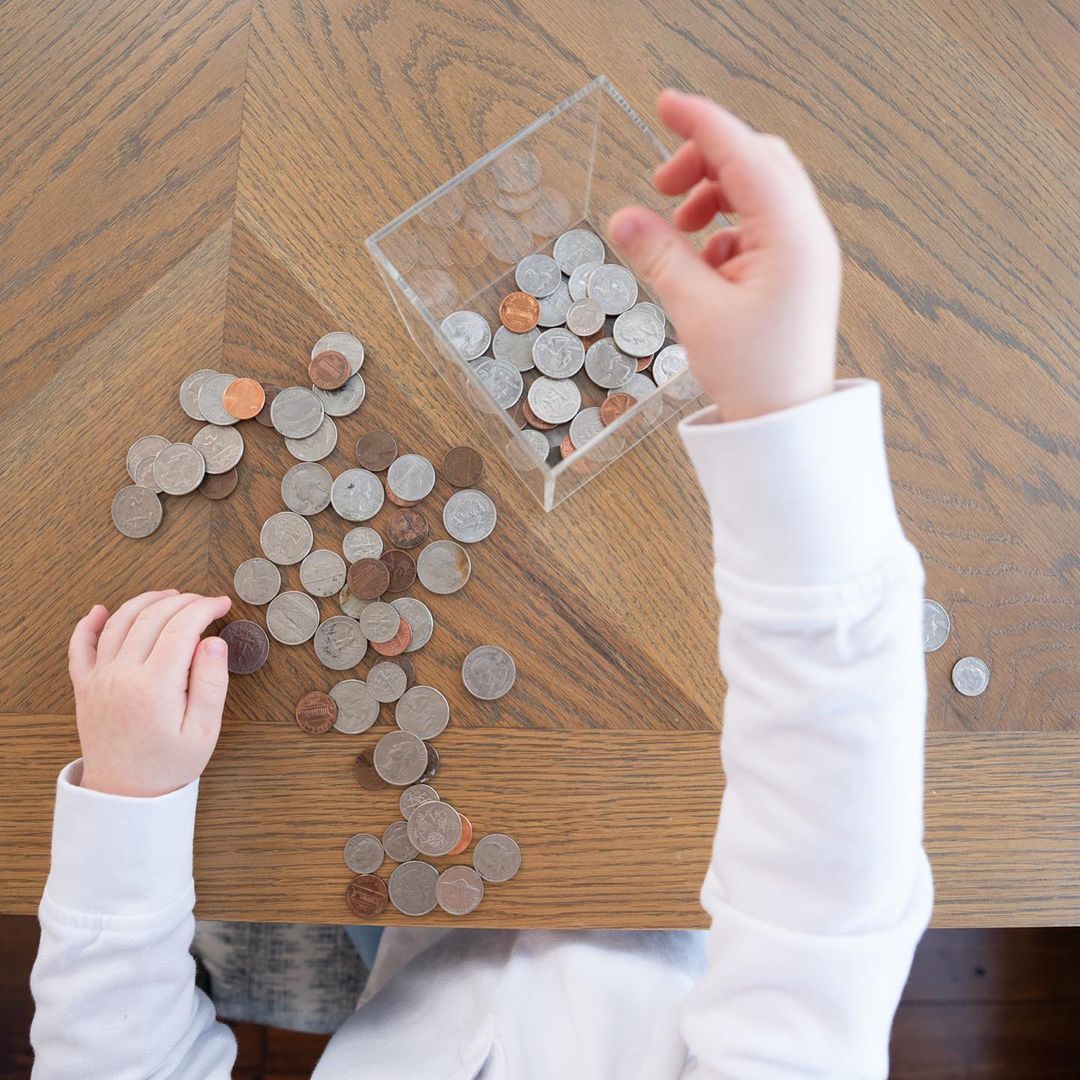
Financial Literacy
Kids' Allowance: Make It Count
Benjamin Talks co-founders and Wall Street vets Nikki Boulukos and Carissa Jordan share everything you need to know to start giving your child an allowance – and financial literacy.
- Written By
- Emily Turilli
Benjamin Talks co-founders Nikki Boulukos and Carissa Jordan know a few things about kids and money. As two former Women-on-Wall-Street with six kids between them, they are united on a mission to make all kids financially fit.
But when it comes to making kids money-smart, where can already-overburdened parents even begin? “In a word: allowance,” says Nikki. “We believe allowance is the foundation of financial fitness. In the same way that you cannot possibly learn to swim without water, you can’t learn to handle money responsibly without, well, handling money.”
Studies show that nearly two-thirds of American families already give their children allowance, and four out of five families link their kid’s cash to the completion of household chores. But are American kids getting any bang for the buck out of allowance? While the stage may be set for teaching children about money, the right script can help make giving an allowance a purposeful family practice.
How does my child earn an allowance?
Children ages four and up can earn a weekly allowance tied to their efforts to keep the household running smoothly. “We prefer to take a ‘good teammate’ approach to allowance,” says Carissa. “Like any successful sports team, each player knows their role and pitches in whenever necessary for the good of the team.” This holistic attitude towards allowance means that rather than tying children’s money to the specific completion of a chore checklist each week (which seems labor-intensive to grown-ups who are already spread thin), kids are expected to “pitch in” and do their part to keep the household running smoothly. From helping to unload the groceries, packing school lunches, and watering the plants, kids should be on duty to help their parents when and where needed.
While some chores might happen daily (i.e., making beds, feeding the dog, emptying the dishwasher), others arise organically in the course of family routines (i.e., carrying out the trash, vacuuming the living room, putting away groceries). The key is that young children know what is expected of them, and parents routinely review the household responsibilities as they grow. “Many young children inherently want to be helpful, and they gain confidence and competence by being held accountable for various tasks around the house,” says Nikki. “The key is to give kids grace when things fall through the cracks every once in a while.” As long as a little helper has made an overall effort to keep the household running smoothly, he should be entitled to his weekly earnings. After all, the purpose of an allowance is to practice handling money–completed chores are an added benefit!
How much allowance should we give each week?
How much should a tiny teammate earn each week? This number is highly variable to each family and depends on age, the number of children, and the family’s financial situation. “As a general guideline, we recommend giving children a weekly allowance that correlates to their age and expenses they are responsible for,” says Carissa, “so my four year old earns $4, my six year old earns $6, and my eight year old earns $8 each week. Their household responsibilities grow as they do, which is reflected in their allowance.” Other families might give $3 a week to each of their children, while still others dole out $20 or more for older children who are accountable for more of their own expenses. The simple answer…there is no simple answer. Any small amount of cash (though preferably divisible) gives children a powerful tool for spending, saving, and giving, while the stakes are low and financial mishaps aren’t too costly.
How do we make the most out of giving an allowance?
Parents and their allowance-earning children should decide:
• What day their allowance will be distributed
• What responsibilities are expected to earn an allowance
• How allowance should be allocated each week to spending, saving, and giving
We designed the Benji Bank with three clear compartments to sort SPEND, SAVE, and GIVE dollars and promote responsible spending, thoughtful saving, and purposeful giving in kids of all ages. Clear containers allow children to quite literally watch their money multiply, which further incentivizes them to earn and save their weekly dollars. Allowing children to see their cash in these three distinct silos sets the stage for a lifetime of financial planning, and having easy access to their cash helps kids interact with their bills and coins with purpose.
Spend
Allocating funds for spending allows kids to take control of their weekly “wants.” The Pokemon cards he can’t live without. The newest Pixar movie rental on AppleTV. The purple glitter nail polish you’d never buy. Giving young children a few dollars to spend at their discretion each week offers them powerful ownership over their money choices. And what about demands for those dreaded in-app purchases? Kids can march to their Benji Banks, withdraw the necessary funds and hand them over to repay parents in real time. By using cash and coins to pay for their digital purchases, kids can actually “feel” the expenses as they spend.
Spend dollars are equally valuable when out and about. “I recently let my seven-year-old tote five of his ‘spend dollars’ on one of our trips to Target,” says Nikki. “Instead of being a passive bystander, he was an empowered buyer, examining prices to determine which purchase was the most worthwhile. Though he labored over his Hot Wheels selection for what felt like hours, the ownership he felt over his purchase made those tiny little race cars infinitely more important to him.” Not only can spend dollars help parents ward off an Aisle 9 meltdown, but the weight of a few dollars in a child’s hand can turn a simple shopping trip into a powerful lesson in financial literacy.
Save
In an age where Netflix offers thousands of shows at our children’s fingertips, Amazon delivers the latest toy mere hours after it’s been ordered, and groceries magically materialize at our doorstep; now, more than ever, it is essential that kids learn the power of delayed gratification. This is where the “save dollars'' comes in. Children should put away a set amount of their allowance every week, without fail, towards a long-term saving goal. Though worthy goals, this is not necessarily meant to fund their college education or help purchase a first car. Instead, the save dollars can also be for the more expensive wants on a child’s wish list that might require weeks or even months of careful planning to earn. A Harry Potter Lego set. A new pair of soccer cleats. Tickets to Disney on Ice. Kids will treasure these possessions and experiences significantly more if they have planned and saved for them.
Setting aside save dollars also offers an easy opportunity to learn the power of interest. “We even recommend sweetening the deal for your littles with the lure of interest,” says Carissa. “Parents can compound their kiddos’ savings to an agreed-upon amount and watch their budgeters blossom.” Adds Nikki, “Saving, like healthy eating, is a habit. If we make it a regular and indisputable part of our children’s earnings, this skill will become a lifelong practice as our kiddos grow into adulthood.” As kids grow older, they may start to put their save dollars to work with an investment account by buying a few of their favorite stocks. The sooner kids start investing their savings, the more they build a financial foundation for the future. By then, the teenage lifeguard, babysitter, or lawn-mower will know that a certain percentage of their paycheck goes into saving and investing for the future, no questions asked.
Give
Just like spending responsibly and saving wisely, thoughtful giving takes practice. But when it comes to getting kids giving, where do we begin? Through schools, religious organizations, and local charities, our children have endless options to give. As parents, we need to offer our children the chance for meaningful giving, one that sets the stage for a lifetime of compassion and generosity. “Give dollars” can be used for the frequent opportunities that arise organically in kiddos’ daily lives. Thanksgiving food drive? Hit the grocery store and let him use give dollars to buy his favorite applesauce for a family in need. Holiday gift drive? Cash out the give stash and let her choose a gift at the local toy store. Supporting the neighborhood Girls Scout troop? Put the give dollars to use and nab his favorite Thin Mints (talk about a win-win?!). “While it takes a tiny bit of planning and a few extra minutes,” says Carissa, “allowing children ownership over these moments of giving lets them experience the joy that comes with a generosity of spirit. That joy then sparks the desire to give further and kick starts a cycle of kindness and empathy.”
When do we transition from giving cash to cards?
Young children should receive their weekly allowance in cash. (Pro tip: Before you begin this family habit, hit the bank and load up on a few months’ worth of one-dollar bills. Nothing says disappointment like a kid’s face when his parents are out of cash on payday!) As kids grow up in an increasingly digital age, it is essential that they get back to basics when it comes to money. Young kids need to physically handle bills and coins, exchange their cash for items they buy, and count the change. They need to learn through experience that once cash is spent, it is gone forever. They need to sort, count, and differentiate the money in their banks and wallets. Before kids become wizzes at everything ApplePay to Zelle, cash must be king for our mini money mavens.
Once our children have experience spending, saving, and giving their allowance dollars in real life, it may be time to transition to a debit card. Debit cards allow older kids to spend, save and give on the go (and when they are out and about without their parents) and help kids transition to a digital future. Innovative fintech companies like GoHenry allow parents to transfer allowance directly onto their child’s debit card and build budgeting, saving, and giving skills with ease.
The Bottom Line
When used wisely, an allowance may be the most powerful tool for making kids financially fit. As team players pitch in around the house and reap the rewards of their hard work, kids gain independence, confidence, and competence. In making decisions on how to spend, tracking weekly savings, or taking ownership of opportunities to give, children are also quietly building the money-smart habits that will endure far into their futures. Most importantly, by making allowance a regular part of the family routine, parents are sparking a daily dialogue around money that is priceless.

